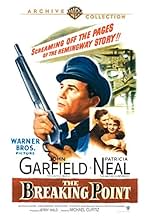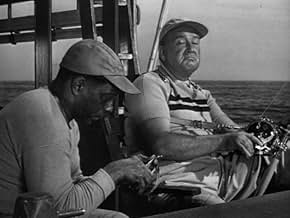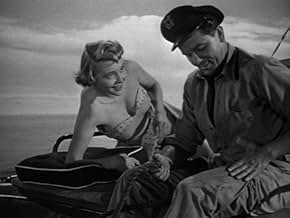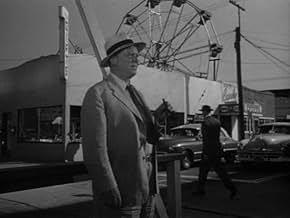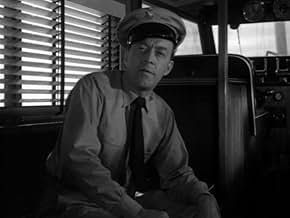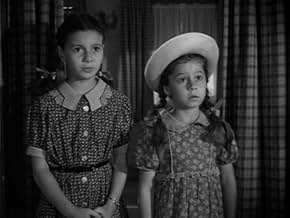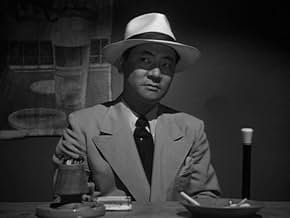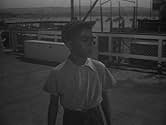VALUTAZIONE IMDb
7,5/10
4934
LA TUA VALUTAZIONE
Aggiungi una trama nella tua linguaAn otherwise moral captain of a charter boat becomes financially strapped and is drawn into illegal activities in order to keep up payments on his boat.An otherwise moral captain of a charter boat becomes financially strapped and is drawn into illegal activities in order to keep up payments on his boat.An otherwise moral captain of a charter boat becomes financially strapped and is drawn into illegal activities in order to keep up payments on his boat.
- Regia
- Sceneggiatura
- Star
- Premi
- 4 vittorie totali
John Alvin
- Reporter
- (non citato nei titoli originali)
Chet Brandenburg
- Taxi Driver
- (non citato nei titoli originali)
Peter Brocco
- Macho
- (non citato nei titoli originali)
Mary Carroll
- Girl at Bar
- (non citato nei titoli originali)
Spencer Chan
- 1st Chinese Immigrant
- (non citato nei titoli originali)
John Close
- Deputy
- (non citato nei titoli originali)
Recensioni in evidenza
Exceptional version of Hemingway's To Have and Have Not is far superior to the Bogart/Bacall film. While the Bogie film was a good picture awash in style and the chemistry of the two leads this is far more realistic without the atmosphere perhaps but loaded with pleasures nonetheless.
For starters this contains one of John Garfield's best performances. Always a fine actor he gets under the skin of his character and makes you understand his desperation and moral conflict, he's riveting every second he is on screen. This was one of his last films before his tragically early death, a sad loss of a great talent who isn't as well remembered as he should be today.
Patricia Neal also scored strongly in this the best of her early roles. She is tough and world weary but also kind and sexy with her whiskey voice and blonde hair. Although it's never stated specifically it's very clear that her character is a prostitute, for the time period a bold point. She and Garfield work very well together and it's a pity his death prevented them from being paired again.
The two other main actors, Phyllis Thaxter and Juano Hernandez, contribute exemplary work as well providing terrific support. Phyllis and Particia Neal are interesting contrasts and their scene together is a study in underplaying. Her scenes with Garfield are also very good, without being explicit they make it clear theirs is a full and happy marriage in all regards with the normal strains and joys.
All this fine work would be for naught if not supported by an excellent screenplay and tight direction from the versatile Curtiz, a man who could direct any genre without problems.
Less romantic in tone but a gripping drama that has been unfortunately obscured by the fame of the other version this is well worth seeking out.
For starters this contains one of John Garfield's best performances. Always a fine actor he gets under the skin of his character and makes you understand his desperation and moral conflict, he's riveting every second he is on screen. This was one of his last films before his tragically early death, a sad loss of a great talent who isn't as well remembered as he should be today.
Patricia Neal also scored strongly in this the best of her early roles. She is tough and world weary but also kind and sexy with her whiskey voice and blonde hair. Although it's never stated specifically it's very clear that her character is a prostitute, for the time period a bold point. She and Garfield work very well together and it's a pity his death prevented them from being paired again.
The two other main actors, Phyllis Thaxter and Juano Hernandez, contribute exemplary work as well providing terrific support. Phyllis and Particia Neal are interesting contrasts and their scene together is a study in underplaying. Her scenes with Garfield are also very good, without being explicit they make it clear theirs is a full and happy marriage in all regards with the normal strains and joys.
All this fine work would be for naught if not supported by an excellent screenplay and tight direction from the versatile Curtiz, a man who could direct any genre without problems.
Less romantic in tone but a gripping drama that has been unfortunately obscured by the fame of the other version this is well worth seeking out.
... He is the same guy as always, struggling against odds, railing about making it, etc., but toned down a bit. He takes umbrage but there is a restraint that is not present in his earlier more angry-young-man roles. Maybe because he looks as little filled out and older and is a family man to boot. There is a relative maturity in the character that is appealing. Despite playing the proverbial "same role" as some actors are thought of as doing, there is no sense that he is phoning it in. And he holds up more effective than ever with the ultimate no-nonsense imperative of tough guys. Tough but regular too, I like the opening sally, i.e., to the effect that when out to sea a certain tranquillity can reign but back on land nothing but trouble. I like that, especially with the ultimate irony to come.
The domestic scenes are not Hemingway, but added for the movie. A wonderful decision. It rounds out Garfield's character giving him a softer side and allows for the domestic sweetness and wholesome prettiness of Phyllis Thaxter to be his wife. I like to feel that her all-to-obvious new hairdo was not lost on her husband and that it might have helped him decide on another matter regarding a certain lady.
Garfield's remark to his 10-year-old daughter about being "too old to run around (the house) like that" (i.e., in night clothes) was a surprising but effective slice-of-life detail that perhaps only in a small way ushers in the new 50s sensibility regarding such matters that will make films more frank and real with youth (teens) issues.
Patricia Neal is stunning as the would-be femme fatale, - would-be because she falls short of treachery. Her worldly manner and sophisticated beauty provides a stark contrast to Garfield's women in the story. She wants to seduce, and pending the outcome, have the goods on him for revenge. Is she too sympathetic for this? Up in the air,,pending definitions. Reliable veteran character actor Wallace Ford has a good gig as a low-level conduit to the underworld. He has good dialogue, pushy and sarcastic with his own clients but totally subservient when around the big boys. A happy addition to the story. The poor boy alone on the pier resonates and is discomforting.
The domestic scenes are not Hemingway, but added for the movie. A wonderful decision. It rounds out Garfield's character giving him a softer side and allows for the domestic sweetness and wholesome prettiness of Phyllis Thaxter to be his wife. I like to feel that her all-to-obvious new hairdo was not lost on her husband and that it might have helped him decide on another matter regarding a certain lady.
Garfield's remark to his 10-year-old daughter about being "too old to run around (the house) like that" (i.e., in night clothes) was a surprising but effective slice-of-life detail that perhaps only in a small way ushers in the new 50s sensibility regarding such matters that will make films more frank and real with youth (teens) issues.
Patricia Neal is stunning as the would-be femme fatale, - would-be because she falls short of treachery. Her worldly manner and sophisticated beauty provides a stark contrast to Garfield's women in the story. She wants to seduce, and pending the outcome, have the goods on him for revenge. Is she too sympathetic for this? Up in the air,,pending definitions. Reliable veteran character actor Wallace Ford has a good gig as a low-level conduit to the underworld. He has good dialogue, pushy and sarcastic with his own clients but totally subservient when around the big boys. A happy addition to the story. The poor boy alone on the pier resonates and is discomforting.
This is a remake of TO HAVE AND HAVE NOT that supposedly from what I've read sticks closer to the Hemingway story. Garfield could play the strong but tormented guy like nobody's business, here however we have most of the information needed in understanding just what's eating at this guy, wearing him down and making him afraid. "A man alone hasn't got a chance," he keeps repeating. But Harry isn't alone. He's got a family that loves him, a plain but good woman he adores, and who adores him. A best friend who is his shipping mate, yet he still can't shake the feeling that somehow the universe is against him, working overtime. He's like a man that needs some spiritual guidance. Something is missing. On first viewing this plays like a well done yarn. On subsequent viewings however, this film begins to haunt. The characters and scenes play on a deeper, more meaningful level. The domestic scenes, usually the throwaway, boring parts of a story like this, become the rock and Garfield and Phylis Thaxter emit genuine emotion and affection for one another that is unusually realistic. Patricia Neal is the temptress here, and in an unusual move, we're not supposed to fall in love with her or maybe even like her, which is evident in how she's physically presented. Her haircut is really bad and she's basically unflatteringly lit and photographed. She too looks realistic: like a once beautiful creature who's been around the block too many times and is starting to look all used up.
Juano Hernandez rounds out the main players as Garfield's friend and shipmate. It was Garfield who insisted the character be a black man and had the relationship between the two beefed up. According to Garfield's daughter, the studio didn't like the idea and tried to talk him out of it, eventually giving up. This casting led to someone (director Michael Curtiz?)coming up with that final shot in the film that hits like a sucker punch to the gut, unexpected and unforgettable.
Watch this one a second time and see if you agree.
Juano Hernandez rounds out the main players as Garfield's friend and shipmate. It was Garfield who insisted the character be a black man and had the relationship between the two beefed up. According to Garfield's daughter, the studio didn't like the idea and tried to talk him out of it, eventually giving up. This casting led to someone (director Michael Curtiz?)coming up with that final shot in the film that hits like a sucker punch to the gut, unexpected and unforgettable.
Watch this one a second time and see if you agree.
With the Depression, the so-called "upper class," the subject of so many plays and films, began to fade and be replaced by the work of playwrights such as Clifford Odets.
John Garfield was the type of leading man who came out of that kind of working man play -- more rugged than romantic, more blue collar than white collar, more at home in a leather jacket than a tuxedo. That leading man type would peak post-war with the likes of Dean, Brando, Steiger, Newman, McQueen, and others. But their predecessor was John Garfield.
Here he stars in his second-last film, as he would soon be blacklisted -- it's "The Breaking Point," based on the Hemingway novel "To Have and Have Not," but not really like the Bogart-Bacall film, which borrowed the title.
In "The Breaking Point," Garfield plays Harry Morgan, who runs a charter boat in California. He has a wife, Lucy (Phyllis Thaxter) and two daughters (Sherry Jackson, Donna Jo Boyce). Times are tough (the original novel took place during the Depression) and Harry is having trouble making enough money to pay off his boat and raise his family.
Lucy wishes her husband would work for his father on his lettuce farm in Salinas, but Harry says all he knows is boats.
Because he needs money, Harry agrees to carry out a shady deal, transporting Chinese to the United States. But when he is cheated out of most of his money, he returns the men where he picked them up. However, someone rats on him and he nearly loses his boat.
When the boat's owner threatens to take the boat for nonpayment, Harry agrees to another shady deal; this one proves more dangerous.
Very intense film which also stars Juano Hernandez, who was wonderful in so many films until his death in 1970; Patricia Neal in her "babe" days, as a former boat passenger who is attracted to Harry; and Wallace Ford, as a foolish man involved in nefarious schemes. William Campbell, whose big claim to fame was that he was married to JFK's girlfriend Judith Exton, plays a low-level criminal.
John Garfield gives a brilliant performance as a stubborn, intense, desperate man who doesn't know where to turn. His last movie, He Ran All the Way, was a B movie and a clear indication that, thanks to the Communist witch hunt, he was on his way out. He died two years later.
Beautifully directed by Michael Curtiz, the end of the movie is especially poignant.
John Garfield was the type of leading man who came out of that kind of working man play -- more rugged than romantic, more blue collar than white collar, more at home in a leather jacket than a tuxedo. That leading man type would peak post-war with the likes of Dean, Brando, Steiger, Newman, McQueen, and others. But their predecessor was John Garfield.
Here he stars in his second-last film, as he would soon be blacklisted -- it's "The Breaking Point," based on the Hemingway novel "To Have and Have Not," but not really like the Bogart-Bacall film, which borrowed the title.
In "The Breaking Point," Garfield plays Harry Morgan, who runs a charter boat in California. He has a wife, Lucy (Phyllis Thaxter) and two daughters (Sherry Jackson, Donna Jo Boyce). Times are tough (the original novel took place during the Depression) and Harry is having trouble making enough money to pay off his boat and raise his family.
Lucy wishes her husband would work for his father on his lettuce farm in Salinas, but Harry says all he knows is boats.
Because he needs money, Harry agrees to carry out a shady deal, transporting Chinese to the United States. But when he is cheated out of most of his money, he returns the men where he picked them up. However, someone rats on him and he nearly loses his boat.
When the boat's owner threatens to take the boat for nonpayment, Harry agrees to another shady deal; this one proves more dangerous.
Very intense film which also stars Juano Hernandez, who was wonderful in so many films until his death in 1970; Patricia Neal in her "babe" days, as a former boat passenger who is attracted to Harry; and Wallace Ford, as a foolish man involved in nefarious schemes. William Campbell, whose big claim to fame was that he was married to JFK's girlfriend Judith Exton, plays a low-level criminal.
John Garfield gives a brilliant performance as a stubborn, intense, desperate man who doesn't know where to turn. His last movie, He Ran All the Way, was a B movie and a clear indication that, thanks to the Communist witch hunt, he was on his way out. He died two years later.
Beautifully directed by Michael Curtiz, the end of the movie is especially poignant.
No one played the haunted/hunted character better than John Garfield (Humphrey Bogart is a close second). Here, Garfield is a boat captain that gets in way over his head. The thing with Garfield's characters, is that even though the audience sympathizes with his plight, the character always brings it on himself. With Garfield's usual acerbic delivery, his Harry Morgan is hard to like but when he is with his family, one sees that he is basically a headstrong but good guy. Even though Michael Curtiz directed this, the tone and especially the ending shot kept reminding me of Fritz Lang. I think this film should be commended for the ending, which although a somewhat happy one, reminds the audience of the affect of one's actions on everyone. This generally was ignored in a lot of the crime dramas from the 30's to the 60's. My only complaint is the Patricia Neal character seemed tacked on for romance sake. She didn't add much and certainly didn't have an impact on the main thrust of the story. But that is a minor quibble. Another gem for one of the move overlooked actors - John Garfield.
Lo sapevi?
- QuizAccording to TCM's Eddie Muller, John Garfield thought this was his best performance and that it was the film of which he was most proud.
- BlooperWhen she first steps onto the boat, Patricia Neal's voice is heard saying "we're off to sunny Mexico," but her lips aren't moving.
- Citazioni
Harry Morgan: You know, my wife dyed her hair.
Leona Charles: Coincidentally I've been thinking of letting mine grow out. Speaking of coincidences, I live in Number Seven. My friends just kick the door open.
- Curiosità sui creditiTHE END close out. All lettering aligned and centered except for the line beneath Warner Bros. that begins PICTURES. It's left registered with whatever wording that followed it 'air brushed' over using the lower right drop shadow pattern leaving a Warner Bros. Pictures _?_?_?_?_ mystery.
- ConnessioniFeatured in The John Garfield Story (2003)
- Colonne sonorePlease Don't Talk About Me When I'm Gone
(uncredited)
Music by Sam H. Stept
Lyrics by Sidney Clare
Sung by Patricia Neal in the bar
I più visti
Accedi per valutare e creare un elenco di titoli salvati per ottenere consigli personalizzati
- How long is The Breaking Point?Powered by Alexa
Dettagli
- Tempo di esecuzione
- 1h 37min(97 min)
- Colore
- Proporzioni
- 1.33 : 1
Contribuisci a questa pagina
Suggerisci una modifica o aggiungi i contenuti mancanti



